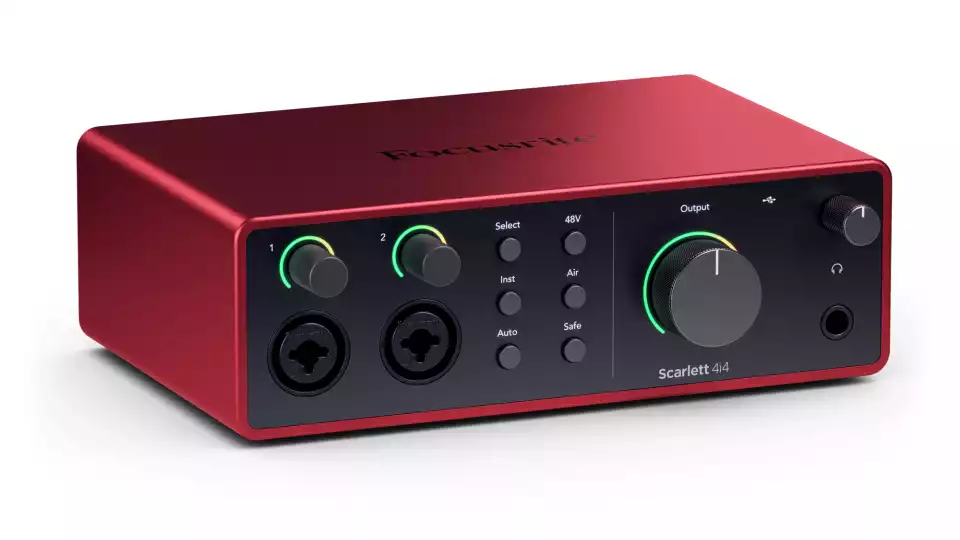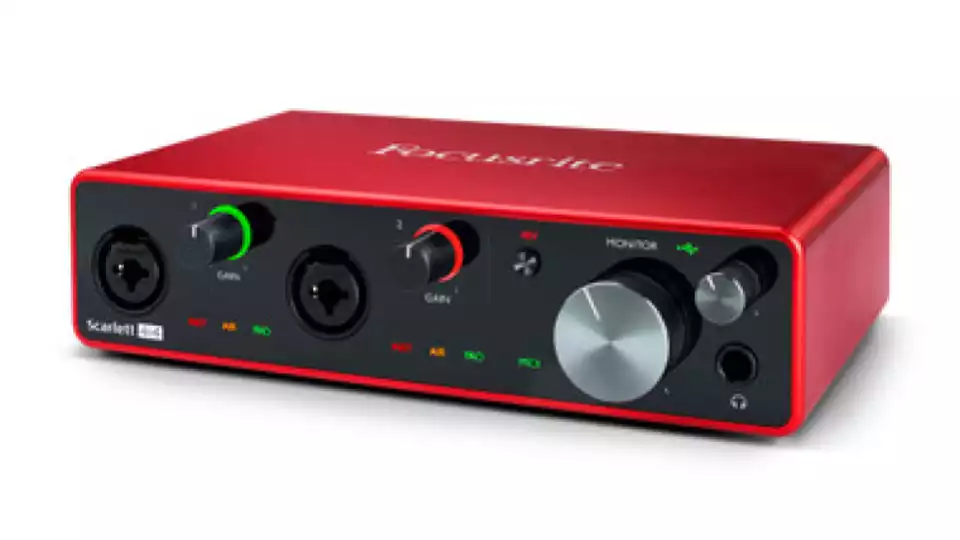Focusrite just recently released their 4th generation of Scarlett interfaces. One of the newly refreshed models is the beloved Scarlett 4i4.
So you might be wondering: Is it time for an upgrade?
We’re going to compare the new 4th Gen 4i4 with the older 3rd Gen model to see what’s new and whether it’s worth the upgrade.
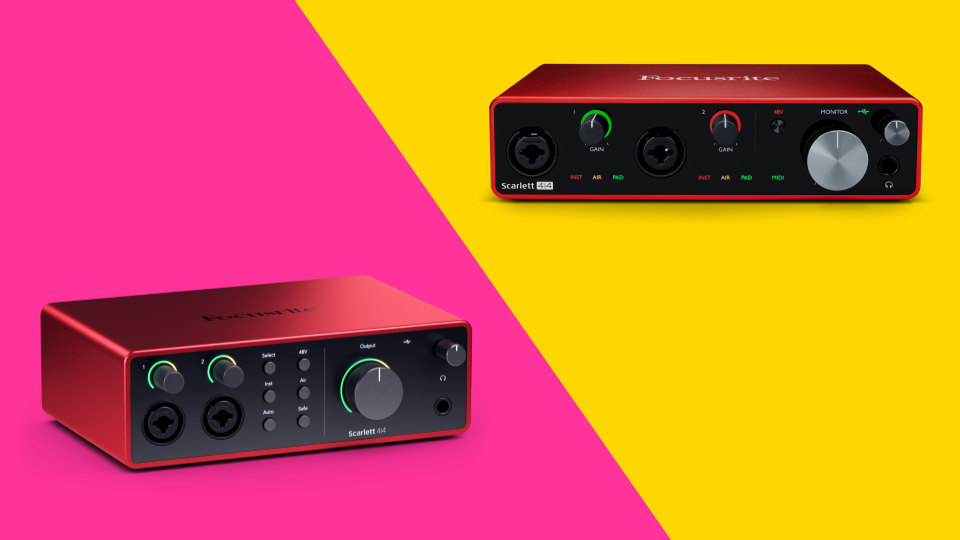
Quick Look: Focusrite Scarlett 2i2 4th Gen vs 3rd Gen
Overall, the jump from 3rd to 4th generation feels like the biggest leap forward compared to previous generations.
|
$279.99
|
$199.99
|
|
|
|
|
|
|
- 2 XLR/line combo inputs
- 2 rear-facing line inputs
- 4 line outputs
- MIDI in/out
- Connects via USB-C
- 69db gain range for mic preamp
- 62db gain range for line input
- 120db dynamic range for line output
- 115db dynamic range for headphone output
- Direct Monitor offers latency-free monitoring
- Front panel buttons removes need for software
- 2 Air Mode settings — hi-range boost and mid-range boost
- Auto-Gain and Clip-Safe mode for automated level adjustment
- Optional external power
- Includes software bundle
- 2 XLR/line combo inputs
- 2 rear-facing line inputs
- 4 line outputs
- MIDI in/out
- Connects via USB-C
- 56db gain range for mic preamp
- 56db gain range for line input
- 108db dynamic range for line output
- 108db dynamic range for headphone output
- Direct Monitor offers latency-free monitoring
- 1 Air Mode setting for hi-range boost
- Includes software bundle
Affiliate Disclaimer
Sonic Atlas is reader-supported. We may earn a commission if you purchase a product using one of our links, at no additional cost to you.
Ease of Use
Scarlett audio interfaces are generally known for their simplicity and ease of use. But the 4i4 in particular saw the most improvement.
Previously, the 4i4 3rd Gen ditched most of the physical controls on the front panel. If you wanted to activate Air Mode or change other settings, you’d have to use the Focusrite Control companion software.
But with the 4th Gen model, the main controls are back on the front panel (like the Scarlett 2i2). You can now activate the Air Modes or toggle between line and instrument inputs right from the device itself.
On top of that, you can use the new Auto Gain and Clip-Safe features with the press of a button.
(More on those features down below)
With everything moved to the front, the 4i4 4th Gen essentially becomes a plug-and-play device like the 2i2 and Solo interfaces.
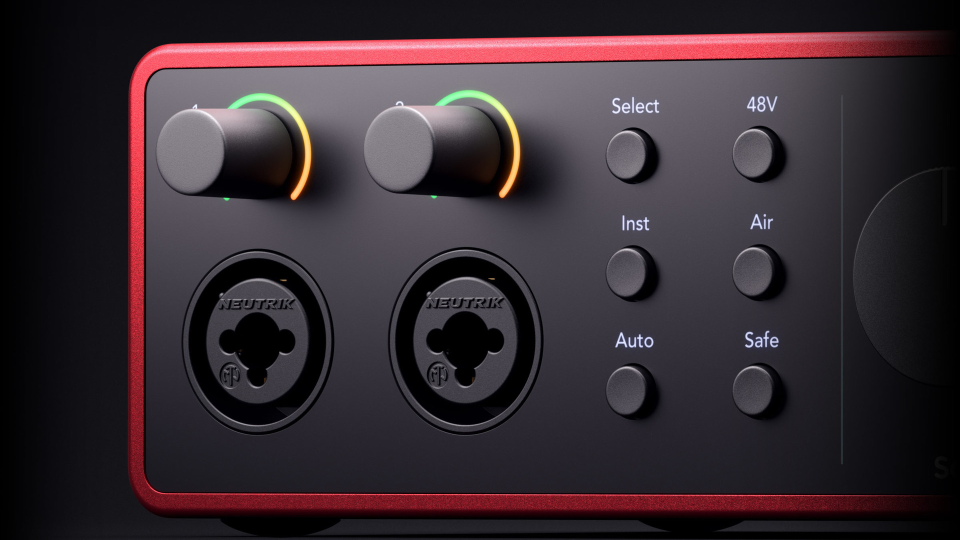
Inputs & Outputs
Nothing’s really changed here. Both the 4th and 3rd generation models are still 4-input, 4-output interfaces. Here’s what you get on either device:
- 2 XLR/line combo inputs on the front
- 2 line inputs on the back
- 4 line outputs on the back
- MIDI in/out on the back
Build Quality
The build quality is incredibly consistent between the two generations. The 4th generation maintains the iconic brushed-red aluminum chassis.
If you hate fingerprints, then you’ll love the 4th gen model! The front and back panels now feature a matte black finish, as opposed to the 3rd gen’s glossy black.
Aside from that, the buttons and dials are all rock solid on both devices. They feel nice to use, and aren’t very wobbly at all.
Audio Quality
Both interfaces can record 24-bit audio at up to 192 kHz. That said, the 4th Gen Scarlett has some major upgrades regarding sound quality and circuitry.
For starters, the 4th gen now uses Focusrite’s RedNet converters, which are found in their high-end interfaces for pro studios and broadcast stations.
In simple terms, this advanced circuitry produces a cleaner signal from analog to digital. It’ll be less likely to introduce static hiss or any other unwanted noise.
Preamps & Gain Range
The 4th gen Scarlett features an extra nice 69db gain range for XLR input. This makes it more friendly with gain-hungry mics like the Shure SM7B.
On top of that, it also features a 62db gain range for line inputs.
Compare that to the 3rd generation’s 56db gain range for both XLR and line inputs. While respectable, it wasn’t enough to satisfy some naturally quiet devices.
Monitor & Headphone Outputs
The 4i4 4th Gen’s main line outputs now offer up to 120db dynamic range, compared to the 3rd generation’s 108db.
Likewise, the headphone amps also saw improvements. 4th gen can now output up to 115db versus the 3rd gen’s 108db.
All that to say the 4th generation Scarletts can output audio at higher volumes.
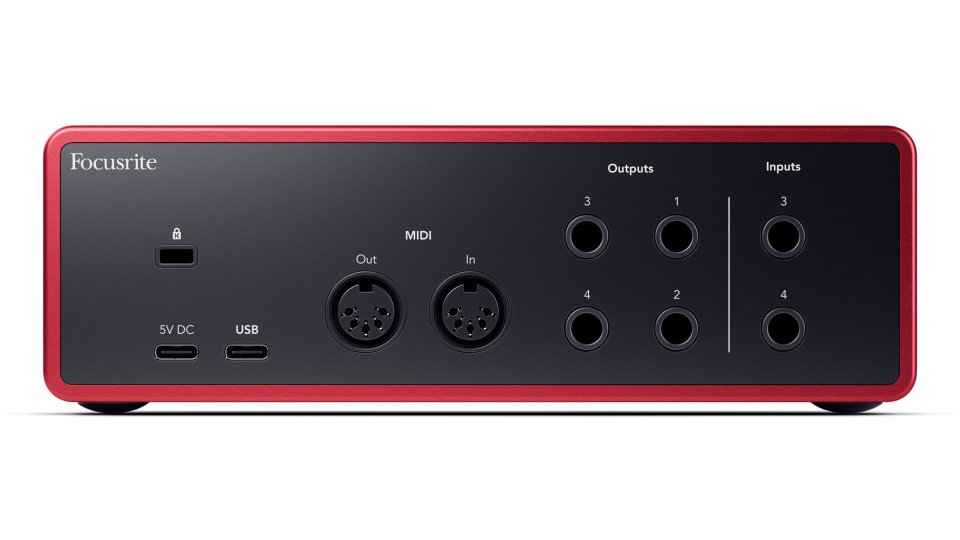
Air Modes
The 3rd generation introduced the original Air Mode. This EQ option boosts the “presence” or high range of a signal to help it cut through a mix.
The 4th generation 4i4 now features two Air modes:
- Presence — This is the same mode introduced in the 3rd gen.
- Harmonic Drive — This new mode boosts a signal’s mid-range for more punch and body. It’s especially useful for instrumentalists, but vocalists can put it to good use too.
I’m of the opinion that more options is a good thing. And having two different EQ modes on the 4th Gen Scarlett gives it a serious edge over the 3rd Gen.
Auto-Gain & Clip-Safe Mode
These two features are only found on the 4th Generation Scarletts, and are completely absent in 3rd gen devices.
As the name suggests, Auto-Gain reads your signal and automatically sets it to the perfect gain level. Just speak, sing, or play for 10 seconds, then the interface will adjust the gain for you.
But sometimes, you might get super excited when recording and you’re louder than expected. This is where the Clip-Safe Mode comes in.
With this mode activated, the interface will automatically reduce your gain levels to prevent clipping and distortion, saving you from doing multiple takes.
Connectivity & Power Supply
Both the 4th and 3rd Gen Scarletts use USB-C to connect to computers and mobile devices. It’s also what powers the device.
But the 4th Gen also features an optional USB-C port dedicated to power supply. This has a few notable benefits:
- It lets you use the 4i4 4th Gen with phones and mobile devices that otherwise don’t provide enough power.
- You can use an external power source and ease the burden on your computer or device.
Bundled Software
As of this writing, both generations come with the same expansive suite of software, including Focusrite’s Hitmaker Expansion bundle.
While I’d never recommend getting an interface just for the software, it’s a nice bonus — especially if you’re relatively new to music production.
Here’s what you get:
DAWs
- Ableton Live Lite
- Pro Tools Artist (3-month subscription)
Mixing, Mastering, and Effects Plugins
- Antares Auto-Tune Access
- Brainworx Bx_console Focusrite SC
- FAST Balancer
- Red 2 & 3 Plug-in Suite
- Relab LX480
- Softube Marshall Silver Jubilee 2555
- Sonnox Vox Doubler
Virtual Instruments
- Native Instruments Massive
- XLN Audio Addictive Keys
- XLN Audio Addictive Drums 2
Subscription Services
- Landr 2-month subscription, plus 5 free masters
- Splice 3-month subscription
Final Thoughts: Should You Upgrade to the Scarlett 4i4 4th Gen?
The 4th Gen Scarlett 4i4 isn’t just a minor update like previous generations. It has several significant benefits over its predecessor.
But a few features in particular make it a compelling upgrade:
- The improved preamps and gain range make some dynamic mics more viable without extra gear, like the Shure SM7B.
- Physical buttons on the front of the device make it more intuitive to use.
- Auto-Gain and Clip Safe Mode help automate input levels, taking out some of the guesswork for beginners.
- Having two different Air modes gives you more EQ options to experiment and record with.
If any of the new features are important to you, then the Scarlett 4i4 4th Gen should be a fantastic upgrade.
But if you mostly record with neutral EQ settings, or you already have other gear to support your gain-hungry microphones, then there isn’t as much reason to upgrade.
